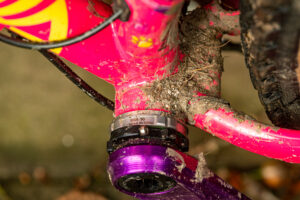Still a really balanced package
Trek Fuel EX 9.7 29 (2018) review

Trail Bike of the Year in association with Alpinestars
You’re only looking at around 150g in weight saving over an aluminium frame, but the carbon fronted Trek Fuel EX 9.7 29 is easily the stiffest bike in those we tested.
>>> 29in Trail Bike of the Year Winner: Vitus Escarpe VRX 29
The Vitus Escarpe VRX 29 and Whyte S-150 S have full aluminium frame, the YT Jeffsy 29 CF is full carbon; the Trek Fuel EX 9.7 29 has a bit of both – carbon front triangle married to an aluminium rear end.

Trek Fuel EX 9.7 29 review
A lot of this is due the Straight Shot down tube design, the direct approach being shorter and stiffer than one with a curve at the head tube junction. On most bikes this curve is necessary to provide clearance for the fork dials, but Trek gets around by limiting bar rotation to about 120 degrees with a device called the Knock Block. This consists of a machined stop bolted to the frame, a unique headset with integrating spacers, and a matching stem.
There were a couple times when we wished the bar would turn a little further, like when weaving up steep zig-zag climbs or loading the bike in the back of car, but if you don’t like Knock Block it is removable, where rubber bumpers on the down tube protect the carbon frame.
This year Trek has fitted a 150mm dropper post to the 19.5in Fuel EX, but like YT and Vitus, this impacts the fit at full extension as we had trouble reaching the pedals. Thankfully, the Bontrager Drop Line post is infinitely adjustable so you can chip away a few millimetres when climbing. The ideal solution however, is 125mm dropper, especially if you’re upsizing to get a longer frame.
Suspension
Trek states that the Fox Rhythm suspension fork on the Fuel EX is custom tuned, but we couldn’t find out if this is a unique tune or just one of the off-the-peg options offered by Fox. What we do know is the Rhythm fork is around 100g heavier that the aftermarket Performance fork. That said, the Grip damper is a big step up from the Motion Control unit in the RockShox Revelation fitted to the Whyte, with less jarring through the hands and more composure in choppy terrain. It also comes with a nicer QR axle, which slots in first time, every time.
Components
As you can see, Trek has invested a lot of budget in the frame and suspension, so something had to give. On the Fuel EX it’s the drivetrain. The other bikes all have 12-speed GX Eagle, the Trek has 11-speed SRAM NX. Shifting is positive but the drivetrain is a little noisier and some of our older testers really missed that 50t Eagle cog as it’s dead handy when grovelling up steep climbs.
We also missed the Bontrager XR4 Team Issue tyres that are listed as standard; our bike actually arriving with Schwalbe Nobby Nics. It turns out Trek ran out of the Bonty tyres but more are on their way so by the time you read this all new bikes should have the original tyres fitted. Swapping tyres is tricky though, the Bontrager Line Comp 30 rims have plastic tubeless rim strips fitted as standard and they work so well it took us a good 10 minutes to get the tyres unseated.
Performance
If you compare geometry on the Fuel EX and YT Jeffsy, you’ll see a lot of the numbers are the same but there’s a few key dimensions that make the Fuel EX ride better. Firstly, it has a slightly lower bottom bracket height. As such it feels more confident on steeper stuff and less perched when railing deep into turns. It is also about 20mm longer in the reach, so is less cramped and has much more balanced handling at speed.
With 130mm travel on the rear and more traditional geometry, the Fuel EX doesn’t quite have the Vitus Escarpe’s confidence when flying down rougher tracks, but it’s still a competent descender, you just have to pick your lines more carefully. The rear suspension is incredibly supple and, unlike the Jeffsy, which tends to ramp up quite suddenly, the Trek makes full use of the suspension.

Verdict
Being sold through bricks and mortar retailers means Trek can’t offer the same stellar build as direct sale brands like Vitus and YT but the Fuel EX is still a really balanced package. The 11-speed drivetrain is a step down but the suspension is first rate, the frame is stiff and lightweight and the bike has the best wheels on test. As a result, it flies uphill and feels incredibly agile on twisty singletrack. If we had to knock out an all-day epic or long weekender at a UK trail centre, the Fuel Ex 9.7 29 is definitely the bike we’d reach for.















